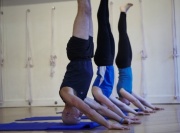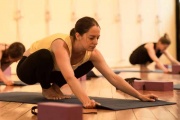Yoga Mandir understands that yoga is learned through a practice and the Institute offers students a place to learn, study and practice yoga. Practitioner students enrol by the term and move progressively through the syllabus to gain a systematic exposure to the principles and practice of Iyengar Yoga. Students of similar levels of experience are drawn together working with one teacher throughout the term to develop a reflective practice.
Each of the Practitioner programs noted below have three components:
- Yogasana coursework
- Pranayama coursework
- Led practice
1. Yogasana Coursework
Yogasana coursework is characterised by instruction and application. The syllabus guides students through Yogasana, pranayama and Yoga philosophy so that Yoga can be engaged in as a reflective practice.
2. Pranayama Coursework
Pranayama is the Yogic art of breathing. Pranayama is introduced in lying position and evolves through repetition with an emphasis on the quality and texture of the breath. This approach develops a steady mind and a capacity to direct our for attention. In a fast paced ever changing world pranayama requires that we let go of characteristics associated with 'doing' and 'achieving' to enter a state of ‘being’ described as a reflective state.
3. Led Practice
Led practice moves students from a focus on instruction to an environment where they can refine observation, develop concentration and continuity of awareness. In these sessions, the Leader calls the asana names as they do the practice with the group but there is no instruction. To enrol in a Led practice students must also be enrolled in a Yogasana course.





